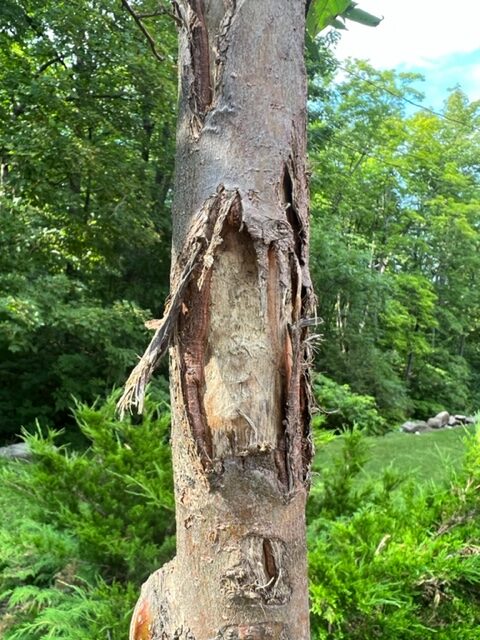
Crabapple – planted a young tree this summer. In the process, the trunk got damaged in 3 places. It seems to be doing OK but my question is do I need to do anything special before winter sets in to make sure these tears don’t get any worse. We are in Zone 5.
Pine – tree is about 5 years old but very frail, yellow needles and they’re now turning brown. I gave it a vitamin stick and I’ve been watering it faithfully, added mulch, making sure it’s not touching the bark. I’m worried it’s going to die.
Thank you. Cathy: 647-232-7661
Dear gardener, thank you for asking these two questions: how to take care of your crabapple tree over winter that has damaged bark, and how to take care of your ailing pine tree.
(1) Your first question is about how to protect your crabapple tree through winter now that its bark has been damaged. How distressing to see the horrible tear in the bark of the tree which goes deep into the inner, phloem, layer of the bark. My first thought is that if the tree was only bought this year, you might be able to return it to the nursery. They may replace it, under warranty, without charge, depending upon their policies.
Research has shown that if you protect a tree wound, the tree could recover. The wound, however, does need to be limited to smaller than a quarter of the circumference of the tree. The guide for this comes from Purdue University. https://www.purdue.edu/fnr/extension/question-tree-bark-damage/
The advice is:
- Keep the tree healthy; mulch and supplement watering during drought conditions.
- Trace the wound with a wood file and sharp knife, removing any loose bark to a clean wound.
- Take black plastic and attach it to the tree wound, just past the wound edge, using small, ¼” staples from a staple gun.
- Attach the plastic so that it forms a seal which will help to maintain a moist environment for parenchyma cells to do their work at ‘compartmentalizing’, and creating wound wood on the perimeter of the damaged area.
- The plastic may need to be checked periodically to be sure it is attached well, until removal.
- Leave the wound covered for about 12 months, then remove carefully.
But, as mentioned, I am not sure that the above method will work since the bark has been damaged in three places, and since the photo shows that at least one of the wounds is nearly half the circumference of the tree. A more rigorous rescue method — tree grafting – will probably be required to give your poor tree a chance of survival. This is not going to be an easy rescue; if you keep it, consider putting your tree into the ICU for a year!
The tissue under the bark is termed the phloem layer. It carries the food synthesized by the leaves to the roots. That inner layer is what you can see in the photo. The flow of nutrients is from the top to the bottom of the tree. Having no bark at some point on the trunk of the tree interrupts this process which will cause the roots and, ultimately, the tree to die.
One method of rescue is called bridge grafting. New Mexico State University has a very good description of how to do bridge grafting. In this kind of grafting, you are taking a number of smaller twigs from the tree, cutting them to size, and marking what is the top and what is the bottom of the twig. Making sure that your twigs are the right side up, cut one end of the twigs at an angle so that the flat side lies flush with the exposed phloem and cambium, and cut the other end into a wedge and tuck it under the bark. Bind twigs and bark all together. If much care it taken, there is a chance that after about a year, the tree will be mended. https://aces.nmsu.edu/ces/yard/2007/090807.html
We wish you luck on this rescue mission.
(2) The second question re your pine tree losing all its pines and not thriving: this is more difficult to answer since I am not sure what kind of pine tree you have. Maybe you could ask this question again and include a photo? A previous question about pine tree diseases was answered very thoroughly, and maybe you will get some ideas from it.
Hoping you have a productive summer and fall with your garden.

